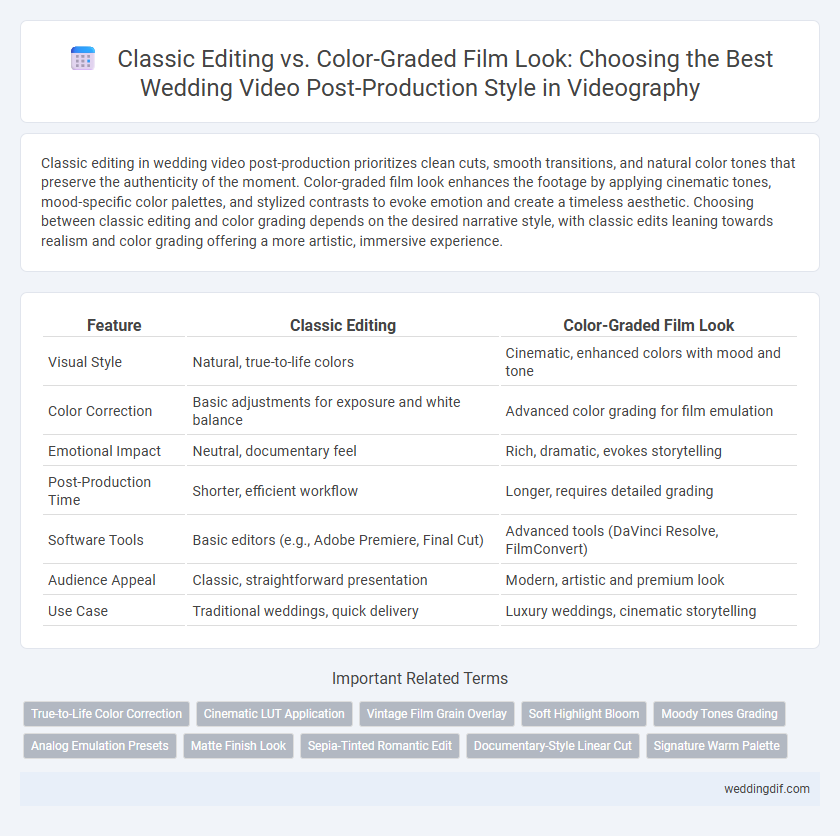Classic editing in wedding video post-production prioritizes clean cuts, smooth transitions, and natural color tones that preserve the authenticity of the moment. Color-graded film look enhances the footage by applying cinematic tones, mood-specific color palettes, and stylized contrasts to evoke emotion and create a timeless aesthetic. Choosing between classic editing and color grading depends on the desired narrative style, with classic edits leaning towards realism and color grading offering a more artistic, immersive experience.
Table of Comparison
| Feature | Classic Editing | Color-Graded Film Look |
|---|---|---|
| Visual Style | Natural, true-to-life colors | Cinematic, enhanced colors with mood and tone |
| Color Correction | Basic adjustments for exposure and white balance | Advanced color grading for film emulation |
| Emotional Impact | Neutral, documentary feel | Rich, dramatic, evokes storytelling |
| Post-Production Time | Shorter, efficient workflow | Longer, requires detailed grading |
| Software Tools | Basic editors (e.g., Adobe Premiere, Final Cut) | Advanced tools (DaVinci Resolve, FilmConvert) |
| Audience Appeal | Classic, straightforward presentation | Modern, artistic and premium look |
| Use Case | Traditional weddings, quick delivery | Luxury weddings, cinematic storytelling |
Introduction to Wedding Video Post-Production Styles
Wedding video post-production styles primarily include classic editing, emphasizing clean cuts and natural lighting to preserve authenticity, and the color-graded film look, which uses advanced color correction to create cinematic, mood-driven visuals. Classic editing maintains straightforward storytelling, often favored for its timeless appeal and emotional clarity. The color-graded film look enhances the narrative with stylized tones and contrasts, offering a modern, artistic interpretation of wedding moments.
Defining Classic Editing in Wedding Videography
Classic editing in wedding videography emphasizes seamless cuts, balanced pacing, and natural color correction to preserve the authenticity of the ceremony and reception. It prioritizes storytelling through clear continuity, smooth transitions, and minimal visual effects, ensuring the focus remains on genuine emotions and key moments. This approach contrasts with color-graded film looks by maintaining true-to-life lighting and hues, delivering a timeless and elegant aesthetic.
What Is Color-Graded Film Look?
Color-graded film look in wedding video post-production refers to the process of enhancing footage by adjusting colors, contrast, and tones to emulate the timeless aesthetic of traditional film. This technique involves using specialized color grading software to create mood, emphasize skin tones, and harmonize scenes, resulting in a cinematic and emotionally resonant visual experience. Unlike classic editing that primarily focuses on basic cuts and transitions, color grading transforms raw footage into a polished filmic masterpiece.
Visual Differences: Classic Editing vs Color-Graded Film
Classic editing in wedding video post-production emphasizes clean cuts, natural lighting, and accurate color representation to preserve the authenticity of the moment. Color-graded film looks apply dynamic color palettes, contrast enhancements, and cinematic tones, creating a mood-driven and stylized visual narrative. The visual difference lies in classic editing's clarity and realism versus the film look's artistic ambiance and emotional depth.
Emotional Impact on Wedding Memories
Classic editing in wedding video post-production emphasizes smooth transitions and natural color tones, preserving the authenticity of moments to evoke genuine emotions. Color-graded film looks enhance the emotional impact by adding cinematic depth, warmth, and mood, creating a timeless and romantic atmosphere. The choice between these techniques shapes how wedding memories are visually remembered and emotionally felt, influencing the viewer's connection to the couple's story.
Client Preferences and Trends
Client preferences in wedding videography increasingly favor the color-graded film look for its ability to evoke emotion and timeless elegance through dynamic color palettes and cinematic tones. Classic editing remains popular for couples valuing simplicity and clarity, offering a clean narrative without visual embellishments. Market trends indicate a rising demand for personalized color grading styles that align with individual wedding themes, enhancing storytelling while maintaining authenticity.
Technical Aspects: Workflow and Tools
Classic editing in wedding videography emphasizes precise cuts, transitions, and audio synchronization using NLE software like Adobe Premiere Pro or Final Cut Pro, prioritizing seamless storytelling without extensive color manipulation. Color-graded film look incorporates advanced color correction and grading techniques with tools such as DaVinci Resolve to enhance mood, depth, and cinematic aesthetics through LUTs, curves, and color wheels. Workflow integration involves balancing render times and hardware performance, ensuring footage maintains visual consistency while optimizing export settings for diverse viewing platforms.
Pros and Cons of Classic Editing
Classic editing in wedding video post-production provides a timeless, natural look preserving authentic colors and emotions, facilitating quick turnaround and lower costs. It may lack the cinematic depth and mood enhancement offered by color grading, potentially appearing flat or less polished on large screens. This straightforward approach suits couples prioritizing genuine storytelling over stylized aesthetics, balancing simplicity with emotional impact.
Pros and Cons of Color-Graded Film Look
Color-graded film look in wedding video post-production enhances mood and emotion by replicating cinematic tones and rich color depth, creating a timeless, artistic feel that resonates with viewers. However, optimizing color grading demands advanced technical skills and precise calibration to avoid unnatural hues or over-processing, which can detract from the video's authenticity. While classic editing offers simplicity and quicker turnaround, color grading requires increased time and specialized software, making it a premium choice for couples seeking a visually striking, bespoke wedding film.
Choosing the Right Style for Your Wedding Video
Choosing between classic editing and a color-graded film look significantly impacts the emotional tone and visual storytelling of your wedding video. Classic editing emphasizes clean cuts and natural colors, preserving the authentic atmosphere of the day, while color grading enhances mood through cinematic tones, contrast, and color palettes tailored to evoke specific feelings. Prioritizing the style that aligns with your wedding's ambiance and personal taste ensures a timeless video that truly reflects your unique celebration.
Classic Editing vs Color-Graded Film Look for wedding video post-production. Infographic

 weddingdif.com
weddingdif.com